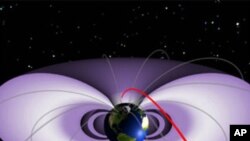Scientists say they have solved the mystery of why electrically-charged particles trapped in radiation belts thousands of kilometers above the Earth suddenly vanish and then reappear during periods of heightened solar activity.
NASA-funded researchers at the University of California, Los Angeles (UCLA) tracked the electrons using data collected simultaneously with 11 different spacecraft.
Their findings show that when bursts of solar energy released by storms on the sun strike Earth’s magnetic field, they send electrons in the so-called Van Allen radiation belts hurtling into outer space. Within a few days, the depleted radiation rings once again swell with a whole new crop of the sun’s highly-charged electrons, which are so energetic that they move at almost the speed of light.
The UCLA researchers note that the highly charged particles that escape the Van Allen belts always stream outward, rather than raining down into Earth’s atmosphere as some theories suggest.
Understanding how solar energy moves in and out of the Van Allen radiation belts has been a critical part of developing accurate space weather forecasts.
Radiation from solar storms can pose a life-threatening danger to the crew of the International Space Station, but it also can damage orbiting satellites, silence ground communications and knock out electric power grids.
The new NASA-UCLA study is published on the Internet in the journal, Nature Physics.
The Van Allen belts are a system of bubble-shaped rings of radiation that encircle the planet. Earth's protective magnetic field holds the Van Allen belts in their position several tens of thousands of kilometers above its surface, and protects the planet from deadly solar, cosmic and other types of space radiation.
The Van Allen belts are named after late NASA astrophysicist James Van Allen, who confirmed presence of the radiation rings in 1958. The pioneering scientist died in 2006 at the age of 91.
Solar Storms Blasting Electrons from Earth's Van Allen Belts





